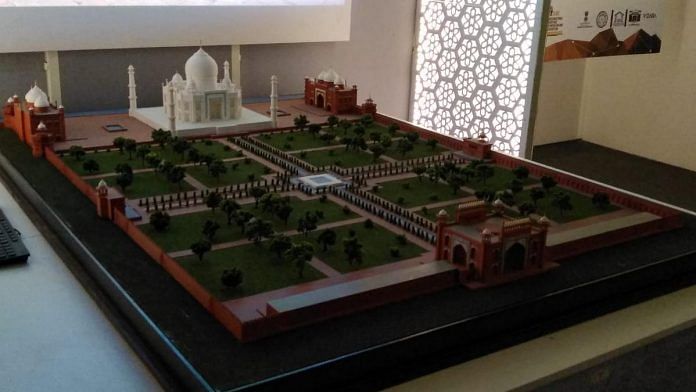New Delhi: An IIT-incubated start-up has made it possible to take a virtual tour of Taj Mahal, offer ‘digital puja’ at the Kashi Vishwanath temple in Varanasi and watch holograms of dancers performing in 3D printed models of monuments in Hampi, Karnataka.
These installations, part of a unique exhibition at the National Museum in New Delhi, are the result of combined efforts of historians and tech experts working for over a decade. The exhibition, which started Tuesday, will go on for a month.
The start-up, Vizara Technologies, has created detailed 3D digital models of Indian heritage sites, transforming how one can experience and learn about them.
The project was funded by the Department of Science and Technology in 2016 and Vizara recently completed digitising five Indian sites — Taj Mahal in Agra, Kashi Vishwanath temple, Konark Sun Temple in Odisha, Rani Ki Vav (stepwell) in Gujarat and the ruins of Hampi in Karnataka.
This digitisation has enabled the start-up to 3D-print true-to-scale models of these monuments in different sizes, which will be displayed at the museum for a month.
Also read: IIT-Delhi students make 5G-enabled power meters that can alert users on energy guzzlers
Virtual reality experience
Among the installations created by Vizara is a room-sized walk-through model of a temple in Hampi. Inside the model, the team has placed holograms of Bharatnatyam dancers, which can provide a glimpse into the kind of performances that used to take place in the temple back in the 15th century.
Apart from these 3D-printed models, the exhibition also has large screens and hand-held controllers that allow visitors to get a virtual experience of walking through these monuments. Visitors can even perform a virtual ‘puja’ or ‘aarti’ at the digital Kashi Vishwanath temple.
Ancient murals have been brought to life with augmented reality. This means that a user can point their tablets or smartphones to ancient paintings and get more information on them.
Using inter-disciplinary approach to restore Indian heritage
Work on the idea of bringing technology to heritage started in 2010 as a collaboration between IIT-Delhi and the Department of Science and Technology to bring an inter-disciplinary approach in conserving heritage.
The idea was to bring the knowledge of engineers and historians out of their respective silos, said Anupama Mallik, CEO & MD of Vizara Technologies.
Teams from over 20 cultural and scientific institutes worked together to identify research problems such as how to restore fading murals that could reveal more about social life in the past.
In 2015, the department decided to fund some start-ups that work for restoring heritage sites by using technology, Mallik told ThePrint. “That is how Vizara was formed in 2016,” she said.
“Such installations can be used in tourist information centres or airports to give visitors an idea of the heritage sites in a city,” she added.
Also read: Taj Mahal is losing its sheen & colour because of DNA-sized carbon particles
Digitally reconstructing heritage sites
Using 3D tech with the expertise of historians, the start-up has also done a conjectural, digital reconstruction for the famous stone chariot of Hampi.
“The top part of it degraded over the years. But there are some photographs of it in the 18th century. So historians have studied that and looked at similar architecture from the era and came up with a conjectural architecture for the top,” Mallik said.
“We now have a 3D-printed stone chariot on which you can screw on the conjectural top and see what it originally looked like,” she said.
Need industry participation
Mallik said completing a full laser scan of a mid-sized monument takes a period of three months and can cost between Rs 20-25 lakh.
However, to use these technologies for other Indian sites, Mallik said, it would not be feasible to keep depending on government funding. She is now hoping to get companies on board to utilise their CSR funds in heritage preservation.
Also read: At IIT Delhi, students are developing 5G-enabled air pollution monitors for the capital



